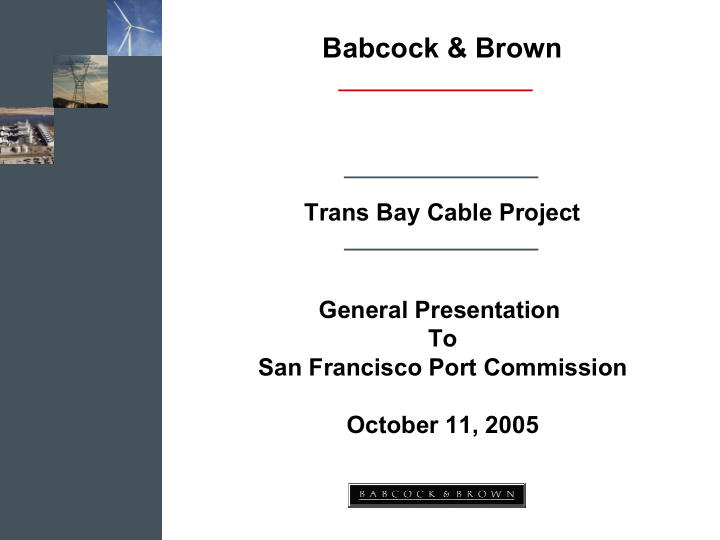



Babcock & Brown Trans Bay Cable Project General Presentation To San Francisco Port Commission October 11, 2005
Trans Bay Cable Project - Summary � The Project will be a new High Voltage Direct Current (HVDC) transmission system that is 59-miles long and runs under the Bay from the generation rich East Bay into San Francisco � HVDC technology has been proven reliable and effective � Provides “generator-like” power, exactly what San Francisco needs � Considered “clean power” a more efficient method to transmit energy underground or underwater � Studies have shown that the Project will provide significant benefits for ratepayers � CAISO has determined that a new transmission line or other reinforcements has to be in place following installation of Jefferson-Martin, CCSF Peaker Project and retirement of all older generation in San Francisco � CAISO “approved” TBC’s HVDC Line as the Long Term Electric Infrastructure Project for San Francisco � TBC determined to be the most viable and economical of all options considered for 2011 and beyond � Operation date for the Project is anticipated to be early 2009 � City of Pittsburg municipal utility will eventually own the Project � Babcock & Brown will develop the project and provide the financing � FERC “approved” the Project providing Babcock & Brown and City of Pittsburg the ability to recover their costs 1
Trans Bay Cable Project – Project Benefits � Significant Environmental Benefits � New, “clean” transmission power source, not expected to have significant environmental impacts, EIR analysis to confirm � Project causes a reduction in transmission system losses, and eliminates associated emissions � When SF Peakers are installed with Trans Bay Cable Project, Peakers will likely operate less � Transmits power from existing power generating facilities near and other transmission lines feeding the Pittsburg substation � TBC Project will not disrupt heavily populated areas or sensitive nature areas � Enhanced Reliability � Higher reliability than a generator � Very secure underwater and underground � Not vulnerable to natural disasters on land that would disrupt other transmission systems � Reduces power flow on other transmission, especially the Peninsula, benefiting entire Greater Bay Area � Long term load serving capability � Completes the Greater Bay Area transmission loop, increasing transmission system security 2
Trans Bay Cable Project – Project Benefits Benefits to San Francisco � CAISO selected TBC Project as the critical third component for San Francisco Reliability � Jefferson to Martin Transmission Line: Shut down Hunters Point 1. San Francisco Peaker Project: RMR removed from Potrero 2. TBC HVDC transmission Line from Pittsburg to San Francisco: Post 2011 (possibility 2010) load 3. serving solution No impact on San Francisco or other Community Residences or Business � Local hire Construction Jobs via Project Labor Agreement � When SF Peakers are installed with Trans Bay Cable Project, Peakers will likely operate � less Completes the Greater Bay Area transmission loop, increasing transmission system � security for SF 3
Trans Bay Cable Project – Major Project Milestones � Development Agreements Executed with City of Pittsburg: January, 2004 � Notice of Preparation Issued Under California Environmental Quality Act (CEQA), with City of Pittsburg as Lead Agency: August, 2004 � FERC “Approval” of TBC Rate Principals: July, 2005 � CAISO “Approval” of TBC Project Need: September, 2005 � Draft Environmental Impact Report (EIR) Issuance: [January, 2006] � Final EIR Issuance: [April, 2006] � City of Pittsburg Certification of EIR: [June, 2006] � Discretionary Acts (Permits, State Easements, etc.) Complete: [September, 2006] � Close of Financing: [October, 2006] � Commercial Operation of Line: [January, 2009] 4
Trans Bay Cable Project – CEQA Procedures for the Project � City of Pittsburg is acting as lead agency for CEQA purposes � Notice of Preparation was issued in August, 2004, and broadly circulated to 276 public agencies and environmental groups � Many state and federal agencies are expected to act as responsible agencies under CEQA, including (for example), State Lands Commission and BCDC � URS engaged to prepare environmental documents � City of Pittsburg engaged Lamphier-Gregory for project planning and independent environmental consulting services � Proposed cable route in the Bay will be the subject of comprehensive environmental surveys as part of the EIR process � Public scoping sessions are planned for the East Bay and San Francisco in October and November 2005 � Draft EIR expected to be circulated for public comment in 1 st quarter 2006 � TBC held Public Open House meetings in Potrero Hill and Hunters Point in September 2005 and the City of Pittsburg in October 2005 5
Trans Bay Cable Project – Submarine Cable Route 6
Trans Bay Cable Project – Aerial View of HWC Converter Site near the Potrero Substation in San Francisco 7
Trans Bay Cable Project – Typical DC Converter Station Control Building Valve Hall AC Cable entry Spare DC Hall Transformer DC Cable entry * AC, AIS Switchyard Valve Cooling Converter Transformer Capacitor Bank Busbar AC Filter *The dimension of the Converter Station can be reduced by using a Gas Insulated Switchyard (GIS) instead of the Air Insulated Switchyard (AIS). 8
Trans Bay Cable Project – Proposed Cable Laying Vessel Cableship – Giulio Verne Main features • Length Overall 133 m • Moulded Breadth 30 m • Draft 8.5 m • Gross Tonnage 10,617 tons • Dynamic Positioning Control • Total propulsion Power 5,710 kW • Capstan 6 m diameter, 50 tons pulling tension • Linear laying machine 10 tons pulling tension • Turntable, external dia. 25 m, capacity 7,000 tons 9
Trans Bay Hydroplow DC Cable Underwater Installation � Cable Installation one to two months � The Cable is taken to the trench bottom by a stinger � Simultaneous lay & burial → cable immediately protected (no cable exposure) � Very effective burial method - Jetting power focused on excavation only � “Minimal” Environmental Impacts 10
Recommend
More recommend